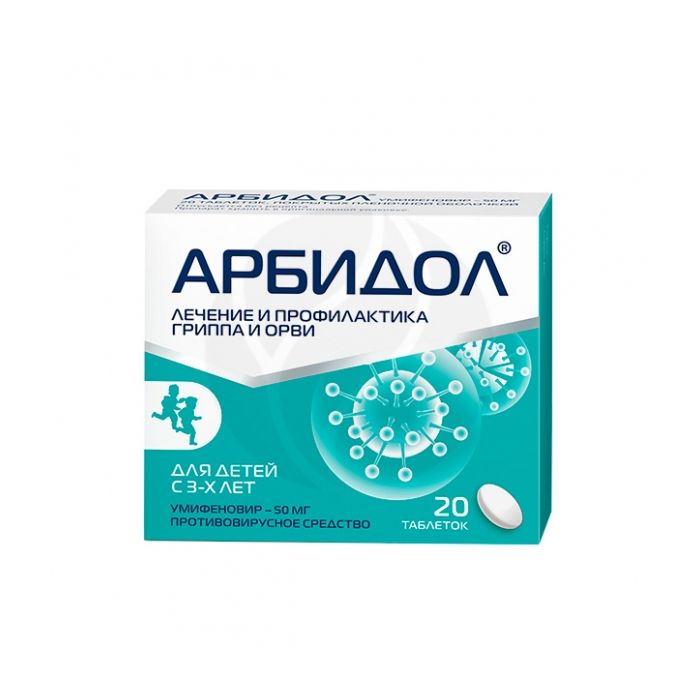Arbidol tablets 50mg, No. 20
Expiration Date: 11/2025
Russian Pharmacy name:
Арбидол таблетки 50мг, №20
Prevention and treatment in adults and children: influenza A and B, other acute respiratory viral infections;
complex therapy of acute intestinal infections of rotavirus etiology in children over 3 years old;
complex therapy of chronic bronchitis, pneumonia and recurrent herpes infection;
prevention of postoperative infectious complications.
The drug is taken orally, before meals.
The reception regimen depends on the age.
Film-coated tablets from white to white with a creamy shade, round, biconvex; at the break - from white to white with a greenish-yellowish or cream shade.
1 tab.
umifenovir hydrochloride monohydrate 51.75 mg,?
which corresponds to the content of umifenovir hydrochloride 50 mg
Excipients: potato starch - 31.86 mg, microcrystalline cellulose - 57.926 mg, povidone (povidone K30) - 8.137 mg, calcium stearate - 0.535 mg, croscarmellose sodium (primellose) - 1.542 mg.
Hypersensitivity to umifenovir or any component of the drug;
children under 3 years old;
I trimester of pregnancy;
period of breastfeeding.
pharmachologic effect
Antiviral drug. Specifically suppresses in vitro influenza A and B viruses (Influenza virus A, B), including highly pathogenic subtypes A (H1N1) pdm09 and A (H5N1), as well as other viruses that cause ARVI (Coronavirus associated with severe acute respiratory syndrome (SARS), rhinovirus (Rhinovirus), adenovirus (Adenovirus), respiratory syncytial virus (Pneumovirus) and parainfluenza virus (Paramyxovirus)). By the mechanism of antiviral action, it belongs to fusion inhibitors (fusion), interacts with the hemagglutinin of the virus and prevents the fusion of the lipid membrane of the virus and cell membranes. It has a moderate immunomodulatory effect, increases the body's resistance to viral infections. It has interferon-inducing activity - in a study on mice, the induction of interferons was noted after 16 hours,and high titers of interferons remained in the blood up to 48 hours after administration. Stimulates cellular and humoral reactions of immunity: increases the number of lymphocytes in the blood, especially T-cells (CD3), increases the number of T-helpers (CD4), without affecting the level of T-suppressors (CD8), normalizes the immunoregulatory index, stimulates the phagocytic function of macrophages and increases the number of natural killer cells (NK cells). Therapeutic efficacy in viral infections is manifested in a decrease in the duration and severity of the course of the disease and its main symptoms, as well as in a decrease in the incidence of complications associated with a viral infection and exacerbations of chronic bacterial diseases. Refers to low-toxic drugs (LD50> 4 g / kg).Does not have any negative effect on the human body when taken orally in recommended doses.
Pharmacokinetics
Absorption and distribution Rapidly absorbed and distributed to organs and tissues. Cmax in blood plasma when taken at a dose of 50 mg is achieved after 1.2 hours, at a dose of 100 mg - after 1.5 hours. Metabolism and excretion Metabolized in the liver. T1 / 2 is 17-21 hours. About 40% is excreted unchanged, mainly with bile (38.9%) and in a small amount by the kidneys (0.12%). During the first day, 90% of the administered dose is excreted.
Side effect
ArbidolЃ belongs to low-toxic drugs and is usually well tolerated. Side effects are rare, usually mild to moderate, and transient. The incidence of adverse drug reactions is determined in accordance with the WHO classification: very often (> 1/10), often (? 1/100, but <1/10), infrequently (? 1/1000, but <1/100), rarely (? 1/10 000, but <1/1000), very rare (<1/10 000), the frequency is unknown (cannot be established from the available data). From the immune system: rarely - allergic reactions. If any of the side effects indicated in the instructions are aggravated or any other side effects not indicated in the instructions are noted, the patient should be informed about this by the doctor. In the treatment of influenza and ARVI, concomitant symptomatic therapy is possible, including taking antipyretic drugs,mucolytic and local vasoconstrictor agents.
Application during pregnancy and lactation
In animal studies, no harmful effects on the course of pregnancy, embryo and fetal development, labor and postnatal development have been identified. The use of the drug ArbidolЃ in the first trimester of pregnancy is contraindicated. In the II and III trimesters of pregnancy, ArbidolЃ can only be used for the treatment and prevention of influenza and if the intended benefit to the mother outweighs the potential risk to the fetus. The benefit / risk ratio is determined by the attending physician. It is not known whether ArbidolЃ is excreted in breast milk in women during lactation. If it is necessary to use the drug ArbidolЃ, breastfeeding should be stopped.
Application in children
The drug is contraindicated for use in children under 3 years of age.
special instructions
It is necessary to follow the recommended scheme and the duration of the drug intake. In case of missing one dose of the drug, the missed dose should be taken as early as possible and the course of taking the drug should be continued according to the started scheme. If, after taking the drug ArbidolЃ for 3 days in the treatment of influenza and other acute respiratory viral infections, the severity of the symptoms of the disease persists, incl. high temperature (38 ? C or more), then you need to consult a doctor to assess the feasibility of taking the drug.
Influence on the ability to drive vehicles and use mechanisms
It does not exhibit central neurotropic activity and can be used in medical practice in people of various professions requiring increased attention and coordination of movements (including transport drivers, operators).
Overdose
There were no cases of drug overdose.
Drug interactions
When administered with other drugs, no negative effects were noted. Special clinical studies devoted to the study of the interaction of ArbidolЃ with other drugs have not been carried out. Information on the presence of an undesirable interaction with antipyretic, mucolytic and local vasoconstrictor drugs in the conditions of a clinical trial was not identified.

